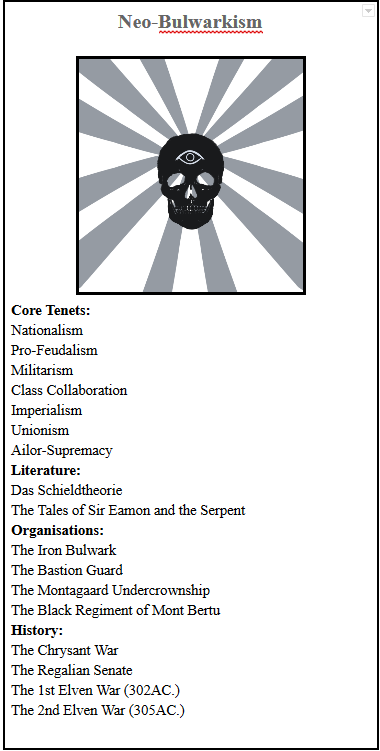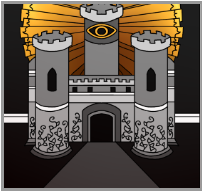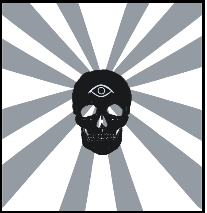┏━━━━━━━━━━━━━━━━━━━━━━━━┓
Neo-Bulwarkism
Part I, of
'La politique d'un Archipel'
┗━━━━━━━━━━━━━━━━━━━━━━━━┛
Authored by François Francisque de Bressuiveé de la Mont Bertu d'Goss
Translated into Common by Gustav Gaspard Fitz Abel
Neo-Bulwarkism
Part I, of
'La politique d'un Archipel'
┗━━━━━━━━━━━━━━━━━━━━━━━━┛
Authored by François Francisque de Bressuiveé de la Mont Bertu d'Goss
Translated into Common by Gustav Gaspard Fitz Abel

Author's Foreword.
The following is an objective research-based summary of the before now, unnamed ideology of, neo-bulwarkism. This, and the following parts of the 'ideology' series I am currently authoring, contain contents which may upset the senstivity of those reading; though, are purely for the furthering of Political Theory within the field of Political Science. A scholarly pursuit can hardly spare the feelings in its harsh rationality, and as such, I expect there to be some confusion, but, will not be justifying my attempts at cataloguing politcal thought beyond this foreword.
Neo-Bulwarkism is a growing but fringe ideology branching from the Feudalist and Authoritarian ideals preached by the Iron Bulwark Party of the Regalian Senate. It is characterised by a rampant jingoism, race politics, Ailor-Supremacy, and dictatorial rule. Though not self-proclaimed, the rule of Charles Montagaard can be characterised under Neo-Bulwarkism: a series of racial laws, crackdown on non-conventional marriage, and foreign conflicts adding to this theory.
Neo-Bulwarkists view the current liberalisation of Regalia as a threat to Ailor culture, and livelihood. The changes to Unionism, changes to State Law, removal of a single head of state, and slow removal of Feudalism from the daily lives of peasants, all are contributing factors to this train of thought. Neo-Bulwarkism calls for the mobilisation of the serfs, freemen, and lower classes, to establish a 'million man' army, and drive the non-humans from the Archipelago in droves, thus reclaiming the rightful land they deem their own. A concurrent thought being: all non-human races have homelands to call their own, with cultures protected by borders, yet, the homeland of the Ailor is slowly ceasing to be culturally and ethnically unique, due to mass-immigration and watering down of Ailor Conservatism.
Neo-Bulwarkists believe any who support laws supporting, mixed racial marriages, the right for non-humans to sit in governance, or the right of non-humans to hold land, to be race traitors and Jacobins. As such, much of the ruling class (having abandoned their Ailor ways for Jacobinism, yet, shifted the term Jacobinism ever leftward) are prime candidates for mockery and are to be shunned out of office.
Neo-Bulwarkists view the current liberalisation of Regalia as a threat to Ailor culture, and livelihood. The changes to Unionism, changes to State Law, removal of a single head of state, and slow removal of Feudalism from the daily lives of peasants, all are contributing factors to this train of thought. Neo-Bulwarkism calls for the mobilisation of the serfs, freemen, and lower classes, to establish a 'million man' army, and drive the non-humans from the Archipelago in droves, thus reclaiming the rightful land they deem their own. A concurrent thought being: all non-human races have homelands to call their own, with cultures protected by borders, yet, the homeland of the Ailor is slowly ceasing to be culturally and ethnically unique, due to mass-immigration and watering down of Ailor Conservatism.
Neo-Bulwarkists believe any who support laws supporting, mixed racial marriages, the right for non-humans to sit in governance, or the right of non-humans to hold land, to be race traitors and Jacobins. As such, much of the ruling class (having abandoned their Ailor ways for Jacobinism, yet, shifted the term Jacobinism ever leftward) are prime candidates for mockery and are to be shunned out of office.

┏━━━━━━━━━━━━━━━━━━━━━━━━━━━━┓
Contents.
I.Etymology
I.Etymology
II.History
III.Sigils
III.Sigils
┗━━━━━━━━━━━━━━━━━━━━━━━━━━━━┛
Etymology.
The term Neo-Bulwarkism stems from its founding philosophy, Bulwarkism, the driving ideology of the Iron Bulwark (a faction present within the Regalian Senate). The term Bulwark derives from the middle-Anglian word 'Bolwerk', which means a "Defensive Wall" (Axford Common Dictionary Vol. IV, 304AC.), representing the cultural and ethnic defence of Ailor by the ideology as a whole. The term, in addition to describing its founding fathers, can be used to describe an array of rising groups, such as the Montagaard Bastion, and Mont Bertu Black Regiment.
History.
The Regalian Senate & its aftermath.
Bulwarkism finds its roots in the year 272AC., but, the ideology had remained simply a reactionary form of Jingoism prior to this, tracing itself back to even the foundation of the Regalian Kingdom, and the crusades into foreign land. The Iron Bulwark, a faction of ultra-Jingoists within the Regalian Senate, could be said to be the first to have been branded with such a term, coining themselves as a defence wall protecting the Regalian Empire. Justinian II often appeased the group, and, had in fact launched the Chrysant War to calm the senatorial faction's calls for warfare and conquest. The Iron Bulwark was primarily interested in the protection of Ailor Dominance, Regalian Values, Unionist Doctrine, and the ever expansion of the military and warfare of the Empire.
During the slow collapse of the Regalian Senate at the hands of Kade and Ivrae intrigue and plotting, Bulwarkism and its namesake Party dispersed and became little more than side-jokes in street performances and plays. While, some lingered onto the ideology driven by the rumours of Justinian II conspiring with Allar assassins to eliminate his rivals, most left the school of thought behind. By 291AC, Bulwarkism stagnated and was lost to the moving of politics, with little hope of recovery.
The rule of Charles the 'Iron Fist'.Bulwarkism finds its roots in the year 272AC., but, the ideology had remained simply a reactionary form of Jingoism prior to this, tracing itself back to even the foundation of the Regalian Kingdom, and the crusades into foreign land. The Iron Bulwark, a faction of ultra-Jingoists within the Regalian Senate, could be said to be the first to have been branded with such a term, coining themselves as a defence wall protecting the Regalian Empire. Justinian II often appeased the group, and, had in fact launched the Chrysant War to calm the senatorial faction's calls for warfare and conquest. The Iron Bulwark was primarily interested in the protection of Ailor Dominance, Regalian Values, Unionist Doctrine, and the ever expansion of the military and warfare of the Empire.
During the slow collapse of the Regalian Senate at the hands of Kade and Ivrae intrigue and plotting, Bulwarkism and its namesake Party dispersed and became little more than side-jokes in street performances and plays. While, some lingered onto the ideology driven by the rumours of Justinian II conspiring with Allar assassins to eliminate his rivals, most left the school of thought behind. By 291AC, Bulwarkism stagnated and was lost to the moving of politics, with little hope of recovery.
Come the rule of the first Regalian Undercrown Charles (Named 'Iron Fist', some say in homage to the Iron Bulwark), Neo-Bulwarkism had arisen in all but name, albeit more successful than its predecessor. Despite lacking the 'Pro-Feudal' stance of the previous Bulwark, Montagaard instead prefers the centralisation of power: directing the authority stolen from the corrupted Lords to one Spirit divined Monarch. The Montagaard Regime passed legislation that would disbar non-humans from marriage with Ailor, prevent non-humans from holding governmental office, and, in general, protect and preserve the Ailor-built positions of state from non-Ailor hands. The Bastion Guard, the military wing of the Regime, often beat non-humans for insubordination, and, was accused of mass harassment of elves and other 'lesser' races. The peak of the Montagaard Neo-Bulwarkism was founded in the wars in Songaskia and the sparking of yet another in Daen. A successful campaign in the Songaskian Deserts, to reinstate a Regalian puppet, and the first battle of the 2nd Elven War are remarked to be Neo-Bulwarkist creations. The Archduke himself is, by scholars, said to be a highly conservative man, and while he himself was never a formal member of the Iron Bulwark, some have theorised him to have been at the most a silent supporter of the Ailor-first policies of the faction. Even so, the term Montagaardism arose during the reign of the Archduke, which can be classified as an offshoot of original Bulwarkism.
Post-Montagaard decline and revival.
Once more, the ideology faded after the death of the Archduke of Gaekgraan, Charles Montagaard; though Neo-Bulwarkism could be argued to have lingered within the Nobility for a while longer (perhaps through the regimented mindset many had adopted to survive), it slowly faded, as followers of the Archduke adopted more moderate stances. However, despite this diminishing nature of Neo-Bulwark influence, pockets of peasantry and merchants clung onto the cultural safeguarding which had been introduced by the Bulwarkists. In Mont Bertu for example, a group of de Gosselin peasants had grown in resentment to the growing disenfranchisement Ailor men had been slumped with, and the growing number of non-humans. The group, known as the 'Black Regiment of Mont Bertu', traversed the Middle-Archipel, arriving in Regalia proper, they say on the bequest of their liege. The Black Regiment would later be founded as a Guard Charter, going on to formally align themselves with Neo-Bulwarkism, and its tenets.
Sigils.

The sigil of House Montagaard is often associated with the Neo-Bulwarkist revival movement, seen to be a symbol of protection, and defence against threats to Unionism and Ailordom. The Bastion, synonymous with the 'Bulwark' can often be seen hanging from the walls of Gaekraan, and neighbouring loyalist provinces. In recent days, after the decline of House Montagaard, the symbol has seen less use, replaced by more traditional sigils such as the Ivare Stork, or, Unionist Eye. In Heartland Anglian circles, the Kade Feathered Dragon often finds much use, however, this tends to be a niche anomaly, not finding much traction with the likes of the Black Regiment, or, the Bastion Guard.

The Skull of Union.
Often associated with the recent emergence of the Black Regiment of Mont Bertu, the skull has become a familiar sight for those oppressed by the sinister Balwarkists. Representing the pure form of Ailor skull shape, the Unionist Skull is a symbolic merging of Ailor genealogy and pure Unionism. A symbol of the inseparable tie between Ailors and their faith, and a sign for any non-humans who consider themselves to be a part of this (in the eyes of the Regiment) exclusive cult. The skull beckons back to the days of Ailor supremacy, when, Emperors cared not only for the spreading of their influence and faith, but for their Ailor stock, and keeping the blood pure of any lesser races. Now, with the abandoning of these time honoured principles, the skull is a relic of a bygone age. The skull itself is often accompanied by an array of heavenly beams, though, due to the high usage by the serfs and peasant class, it is rarely displayed in anything grander than black dye.


This treatise is publicly available within libraries and book-stores across Regalia Proper.
Last edited:











